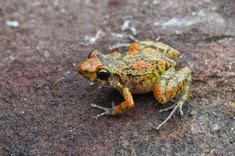The Southern cricket frog can jump to a height of 60 times its body length that's like a person jumping a 38 story building.
Ticklishness, a trait that was long thought to be unique to humans and our closest primate relatives, evolved in great apes as a means of social bonding: It engenders light-hearted interactions between parents and children, as well as helping youngsters hone their self-defense skills during tickle battles with siblings.
Over the past decade, animal behaviorists have gathered considerable evidence that suggests rats, of all creatures, are ticklish too. When stroked in certain body regions, the rodents emit high-pitched chirps. These chirps seem to signify joy, because the rats will run mazes and press levers if they learn they'll be rewarded with a good tickle afterward. Rats' chirping, the researchers say, is akin to human laughter.
Ticklishness probably evolved in rats for similar reasons that it evolved in apes. Rats are extremely playful animals, engaging in rough-and-tumble play as juveniles just as young apes do, chirping all the while.
Not only do fish sleep, they even suffer from insomnia.
Take the zebrafish, for example a species commonly found in aquariums. When the little swimmers go to sleep for the night, they droop their tails and sink to the bottom of their tanks. Studies on their sleep patterns have shown that if they're kept awake at night, zebrafish seem groggy, unable to learn as quickly as they can during the day.
One study found that zebrafish with faulty hypocretin receptors the same issue that sometimes leads to sleep problems in humans slept, on average, 30 percent less than normal specimens.
Not only do they equip themselves with pincers, poisonous whips for tails, and full body armor, scorpions can even scare the heck out of any reasonable person by glowing in the dark.
When illuminated by ultraviolet rays from a black light, the armored arachnids glow an unnatural neon blue. UV light that hits these creepy crawlies gets converted by proteins in their exoskeletons into light of a blue hue, which is visible to the human eye. Arachnologists have spent untold hours trying to figure out what this fluorescence is good for. Recent research suggests it may be their way of gauging the amount of moonlight shining down on them. Scorpions are nocturnal, light-abhorring creatures. They prefer to lie low on brightly lit nights.
For penguins trying to survive a harsh Antarctic winter, huddling is a matter of life or death. Birds within a colony crowd together so tightly that individual movements are impossible. Collective movements are a must, however: The penguins on the periphery would die of cold if they weren't continuously being reshuffled toward the center of the crowd. To achieve continual reorganization, the million-member huddle does the wave. In the same way that sound waves propagate through a fluid only much more slowly each penguin takes a tiny, 2- to 4-inch-long step, and the traveling wave of small steps leads to large-scale reshuffling.
Penguins are much better at "going with the flow" than humans, who also tend to move in waves when packed together in large, dense crowds, but sometimes end up getting crushed. No one knows why waves are turbulent and dangerous in a human crowd, but perfectly civil in a penguin one.
Koalas, doll-sized marsupials that climb trees with babies on their backs, have fingerprints that are almost identical to human ones. Not even careful analysis under a microscope can easily distinguish the loopy, whirling ridges on koalas' fingers from our own.
Close human relatives such as chimps and gorillas have fingerprints as well. The remarkable thing about koala prints is that they seem to have evolved independently from the others. On the tree of life, primates and modern koalas' marsupial ancestors branched apart 70 million years ago. Scientists think the koala's fingertip features developed much more recently in its evolutionary history, because its close relatives (such as wombats and kangaroos) lack them.
The fact that primates and koalas separately evolved fingerprints reveals the feature's anatomical purpose. The lifestyles of both koalas and primates require a lot of hand-grasping, both for eating and climbing. It seems that the multidirectional ridges on our fingers evolved to help us grasp.





